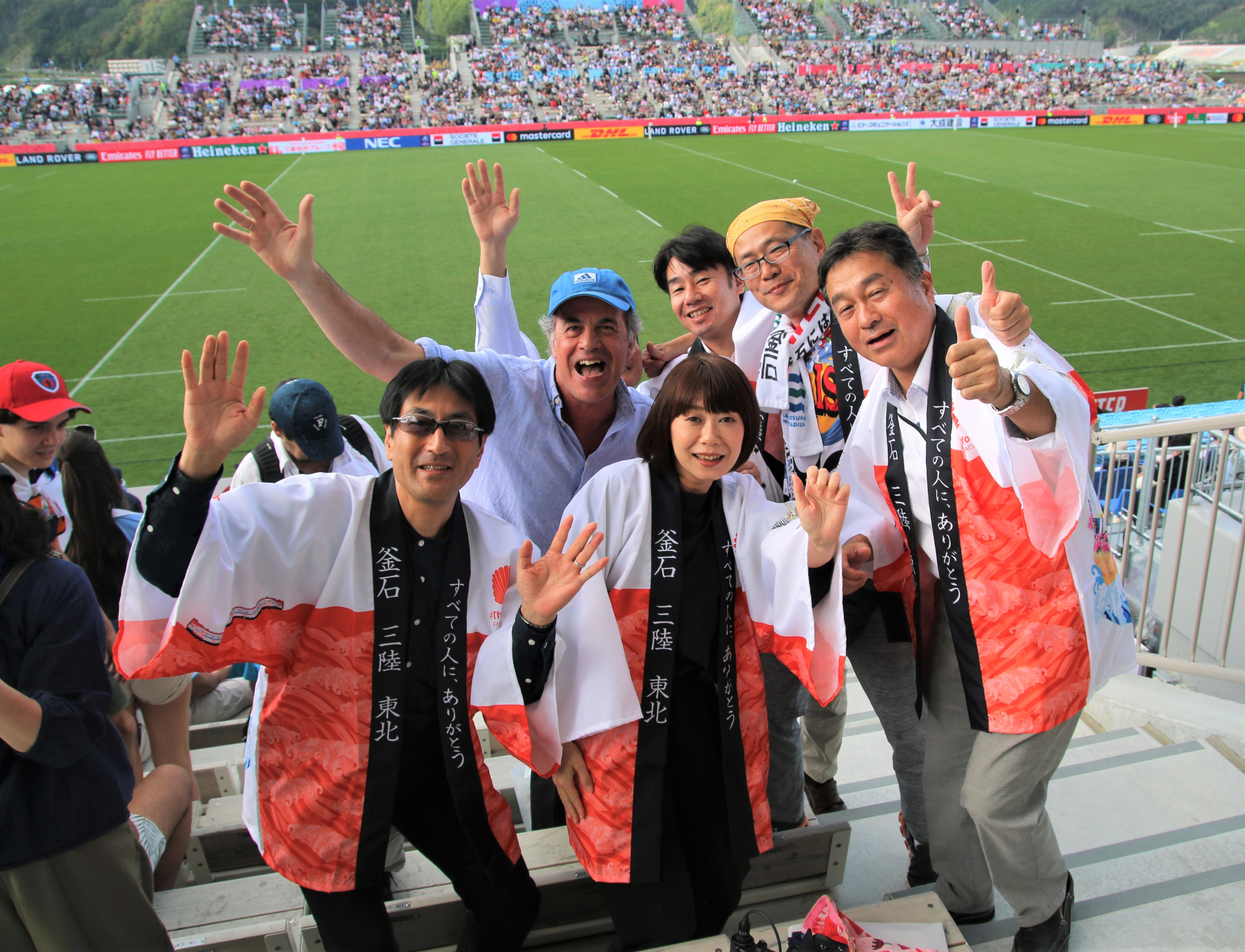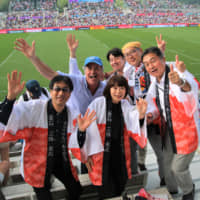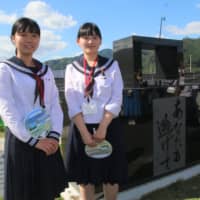High school student Yukime Sasaki and two other young girls were all beaming smiles to greet hundreds of visitors who stopped by on Wednesday afternoon before a Rugby World Cup game between Uruguay and Fiji.
The three were there as "memory keepers" of the 2011 Great East Japan Earthquake, trying to not let the memory of the natural disaster fade with time.
They hope that the two Rugby World Cup games played in their native Kamaishi, Iwate Prefecture, would serve as a good reminder of that.
The trio stood at a prayer monument, which was installed in June on the premises of Kamaishi Unosumai Recovery Memorial Stadium. The venue was built in the coastal Unosumai district that was wiped away with the tsunami eight years ago.
Sasaki is one of the Kamaishi's accredited memory keepers and took lessons from the city and a university professor to understand what messages they would need to hand down.
Sasaki, a Kamaishi High School senior who couldn't attend a couple of recent games that were staged at the newly built venue, was delighted to finally make it here on the sport's biggest stage.
"I'm so excited to be here," Sasaki said. "I'm surprised to see this many people. And as much as I want them to enjoy the rugby game, I want them to know the attractiveness of Kamaishi — and the disaster."
An inscription is carved into the monument. It reads, "Anata mo nigete," (You run away from here, too).
Among various options, project members decided to write the phrase so that it would remind people of the need to have a sense of urgency and quikly move and evacaute during a tsunami.
Sasaki, who was a third-grader at Kamaishi Elementary School , which was destroyed by the tsunami, lost her home that was also struck by the disaster. The family was forced to live in a temporary house for years before it got out of it this March.
The painful experience drove her to think of the need to keep sharing memories of the tragedy.
Sasaki said that this location in Unosumai endured tough times, including draining the water because of the tsunami. But she added that she is "thrilled to see" the place magically turned into something where so many people gathered for the Rugby World Cup.
"It's incredible to see this scenery," she said. "I'm happy to be part of this."
Rugby's ties to community
Yoshihiko Sakuraba perhaps knows better than most about how much rugby means to the community and how special it is for the town to host games during the sport's biggest event. The 53-year-old is a former Nippon Steel Corporation Kamaishi player.. The now-defunct team was one of the most successful teams in Japanese rugby history, capturing seven straight Japan national championships from the late 1970s.
Eventually, the splendid days of Nippon Steel team came to an end. The team was reborn as a club team named the Kamaishi Seawaves, who play in the Top Challenge League, a second-tier circuit of the Top League.
Sakuraba now serves as the Seawaves general manager and as 2019 RWC ambassador. The Akita native, who calls Kamaishi his second hometown, has been one of the biggest proponents of bringing World Cup games to the city.
He was emotional on this historic day, when a World Cup contest finally came here.
Throngs of people gathered here, traveling from inside and outside Japan to reach the stadium.
When they entered, it became a crowded stadium in the this cozy, 30,000-plus popultion city, which actually had three times as many residents during its peak period of iron manufacturing.
"It wasn't necessarily easy to make this happen," Sakuraba said, referring to some objections to hosting the World Cup in a city that was devasted by the disaster so badly. "But to have a day like this, I'm extremely happy and this would be an opportunity for people to make a start. We would like them to enjoy the moments here and to make the experience into their treasure moving forward into the future."
Significance of competition
John McKee, a New Zealander who serves as Fiji's head coach, seemed to understand the significance of holding matches in Kamaishi.
"Certainly there is some significance with the game being at the Kamaishi Recovery Memorial Stadium," McKee said on Tuesday, one day before his squad's match against Uruguay. "After the tsunami that devastated the area, you understand that rugby is more than just a game and we know that it is very important for the people of this area and for the team to pay our respects to the people of this region."
Longtime rugby fan Yukio Asano, a Miyagi Prefecture resident, noted that Sendai was a World Cup host candidate that wasn't selected. But he said that it was much more fitting that Kamaishi was chosen as the only town in Tohoku among the 12 host cities to stage World Cup games.
"Sendai is a lot more convenient in many different ways, but I think this place deserves this more than Sendai," Asano said. "That is because, for one, there was the disaster. Plus, there was the Nippon Steel Kamaishi and there's a certain rugby culture here."
Overseas fans also enjoyed the phenomenal atmosphere at the stadium, which can hold up to just 16,000 people. Some of them said they were impressed with the town's recovery in just eight years.
"I think Japan did a very good job in reconstructions," Uruguayan fan Martin Rodriguez said before Wednesday's game, which was played in great weather with the vivid blue sky above. "The facilities are really, really good. I think Japanese people did a very good job."
Fijian Joana Tukana said that Kamaishi is certainly a much smaller city than Sapporo, where her national team competed in its first game against Australia on Saturday. But she said that she was "glad" to bring the Fijian national squad to the Tohoku city, acknowledging the meanings of it being a World Cup host.
Tukana added that Kamaishi has become "a special place" for her now.
Fiji hooker Mesulame Dolokoto called it "pretty unreal" competing in Wednesday's contest, which was witnessed by eager rugby fans, a couple of thousand elementary and junior high school students who were invited from Kamaishi and other nearby cities, among others.
"It was pretty unreal seeing the crowd," Dolokoto said of the atmosphere in Kamaishi after the Polynesians' stunning 30-27 loss to Uruguay. "And particularly after the disaster that they had, to get that level of support was pretty unreal."






















With your current subscription plan you can comment on stories. However, before writing your first comment, please create a display name in the Profile section of your subscriber account page.